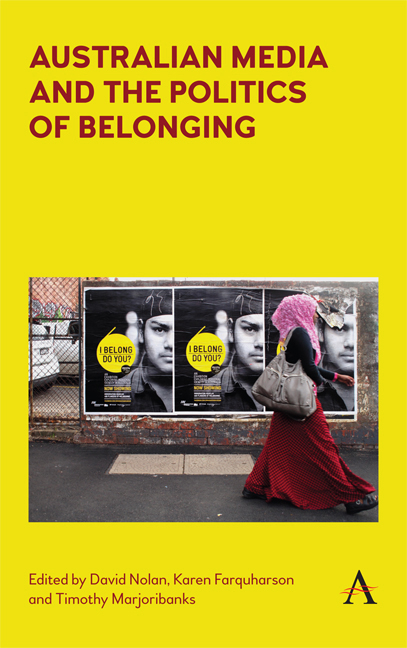Book contents
- Frontmatter
- Contents
- List of Illustrations
- Acknowledgements
- Part I THEORIZING BELONGING IN CONTEMPORARY AUSTRALIA
- Part II SUDANESE AUSTRALIANS, MEDIA PRACTICES AND THE POLITICS OF BELONGING
- Part III SHIFTING THE POLITICS OF BELONGING: MEDIA INTERVENTIONS AND POSSIBILITIES FOR TRANSFORMATION
- Chapter 8 Towards An Australian Framework For Best Practice In Reporting News Involving Muslims and Islam
- Chapter 9 Creating Media, Creating Belonging: Young People from Refugee Backgrounds and the Home Lands Project
- Chapter 10 Creating Belonging: The Possibilities and Limitations of an Organizational News Media Intervention
- Notes on Contributors
- Index
Chapter 10 - Creating Belonging: The Possibilities and Limitations of an Organizational News Media Intervention
from Part III - SHIFTING THE POLITICS OF BELONGING: MEDIA INTERVENTIONS AND POSSIBILITIES FOR TRANSFORMATION
Published online by Cambridge University Press: 21 June 2018
- Frontmatter
- Contents
- List of Illustrations
- Acknowledgements
- Part I THEORIZING BELONGING IN CONTEMPORARY AUSTRALIA
- Part II SUDANESE AUSTRALIANS, MEDIA PRACTICES AND THE POLITICS OF BELONGING
- Part III SHIFTING THE POLITICS OF BELONGING: MEDIA INTERVENTIONS AND POSSIBILITIES FOR TRANSFORMATION
- Chapter 8 Towards An Australian Framework For Best Practice In Reporting News Involving Muslims and Islam
- Chapter 9 Creating Media, Creating Belonging: Young People from Refugee Backgrounds and the Home Lands Project
- Chapter 10 Creating Belonging: The Possibilities and Limitations of an Organizational News Media Intervention
- Notes on Contributors
- Index
Summary
Introduction
Media interventions aim to disrupt and reshape power relations between the media industry, including professional journalists, and other participants in society. The intervention that is the focus of this chapter, the AuSud media intervention, was designed to engage mainstream media and to influence the ways in which Sudanese Australian people are portrayed by the Australian media. As part of this process, the intervention's objective was to enable Sudanese Australians to put forward their own voice in the media and to provide them with a means of being heard. It sought to do this by training Sudanese Australians in journalism, by helping them to create a website through which to disseminate their journalistic work and by providing them with connections into Australian institutions such as the Australian Broadcasting Corporation (ABC) and Victoria Police. In addition, by recruiting journalists from established and mainstream media institutions to help realize these objectives, the intervention aimed to transform mainstream media journalists’ perceptions and stereotypes of the Sudanese Australian community.
The media intervention that is the focus of this chapter had two distinctive features. First, it aimed to provide professional journalistic training to members of a newly arrived community who were being harassed by institutions of power, notably the police, parliamentarians and the established media, in order to give them a voice. Second, it gave them direct links into those institutions that were doing them the most harm, the police and the media, to allow the community to be heard directly.
Within this context, this chapter asks two main questions: What were the defining features and outcomes of the AuSud media intervention, and what challenges did the intervention face? What are the lessons of the AuSud media intervention for other interventions? This chapter argues that the AuSud media intervention engaged successfully to some extent with questions of voice and listening, but that it faced profound challenges around ownership and sustainability. These outcomes reveal the importance of analysing media interventions as sites of power and as processes that unfold over time.
- Type
- Chapter
- Information
- Australian media and the politics of belonging , pp. 177 - 194Publisher: Anthem PressPrint publication year: 2018



